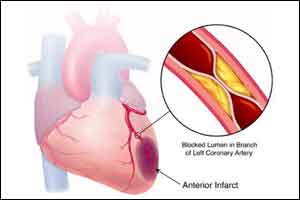- Home
- Editorial
- News
- Practice Guidelines
- Anesthesiology Guidelines
- Cancer Guidelines
- Cardiac Sciences Guidelines
- Critical Care Guidelines
- Dentistry Guidelines
- Dermatology Guidelines
- Diabetes and Endo Guidelines
- Diagnostics Guidelines
- ENT Guidelines
- Featured Practice Guidelines
- Gastroenterology Guidelines
- Geriatrics Guidelines
- Medicine Guidelines
- Nephrology Guidelines
- Neurosciences Guidelines
- Obs and Gynae Guidelines
- Ophthalmology Guidelines
- Orthopaedics Guidelines
- Paediatrics Guidelines
- Psychiatry Guidelines
- Pulmonology Guidelines
- Radiology Guidelines
- Surgery Guidelines
- Urology Guidelines
ACC/AHA/NASPE Guidelines for Permanent Pacing After the Acute Phase of MI

ACC/AHA/NASPE Guidelines for Implantation of Cardiac Pacemakers and Antiarrhythmia Devices” updates the previous versions published in 1984, 1991, 1998, and 2002.Indications for permanent pacing after myocardial infarction (MI) in patients experiencing AV block are related in large measure to the presence of intraventricular conduction defects. The criteria for patients with MI and AV block do not necessarily depend on the presence of symptoms. Furthermore, the requirement for temporary pacing in AMI does not by itself constitute an indication for permanent pacing.
Recommendations for Permanent Pacing After the Acute Phase of Myocardial Infarction
Class I
- Permanent ventricular pacing is indicated for persistent second-degree AV block in the His-Purkinje system with the alternating bundle-branch block or third-degree AV block within or below the His-Purkinje system after ST-segment elevation MI. (Level of Evidence: B)
- Permanent ventricular pacing is indicated for the transient advanced second- or third-degree infranodal AV block and associated bundle-branch block. If the site of block is uncertain, an electrophysiological study may be necessary. (Level of Evidence: B)
- Permanent ventricular pacing is indicated for persistent and symptomatic second- or third-degree AV block.(Level of Evidence: C)
Class IIb
- Permanent ventricular pacing may be considered for the persistent second- or third-degree AV block at the AV node level, even in the absence of symptoms. (Level of Evidence: B)
Class III
- Permanent ventricular pacing is not indicated for transient AV block in the absence of intraventricular conduction defects. (Level of Evidence: B)
- Permanent ventricular pacing is not indicated for transient AV block in the presence of isolated left anterior fascicular block. (Level of Evidence: B)
- Permanent ventricular pacing is not indicated for the new bundle-branch block or fascicular block in the absence of AV block. (Level of Evidence: B)
- Permanent ventricular pacing is not indicated for persistent asymptomatic first-degree AV block in the presence of bundle-branch or fascicular block. (Level of Evidence: B)
For further reference log on to:
Next Story
NO DATA FOUND

Disclaimer: This site is primarily intended for healthcare professionals. Any content/information on this website does not replace the advice of medical and/or health professionals and should not be construed as medical/diagnostic advice/endorsement or prescription. Use of this site is subject to our terms of use, privacy policy, advertisement policy. © 2020 Minerva Medical Treatment Pvt Ltd